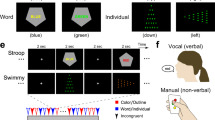Abstract
Some cognitive behavior therapy methods focus upon verbal cognition, others place more emphasis upon imagery. These two modes of cognition are represented differently in the brain: In most individuals imagery is a function of the right cerebral hemisphere and verbal cognition is processed in the left hemisphere. Two cognitive behavioral methods, one emphasizing imagery, the other verbalizations, were used by speech-anxious subjects, half of whom showed greater right hemisphere usage, half greater left hemisphere usage as indicated by their lateral eye movements in response to reflective questions. Although only approaching significance, the results suggested that treatment was most effective if it employed cognition of the subjects nonpreferred hemisphere. This may suggest that clients with clear imagery may benefit more from a verbal strategy, while clients with frequent self-verbalization may benefit more by using coping imagery.
Similar content being viewed by others
References
Bakan, P. Hypnotizability, laterality of eye-movements, and functional brain asymmetry.Perceptual and Motor Skills 1969,28 927–932.
Benton, A. L., & Van Allen, M. W. Impairment of facial recognition in patients with cerebral disease.Cortex 1968,4 344–358.
Bogen, J. E. The other side of the brain I. Dysgraphia and dyscopia following cerebral commisurotomy.Bulletin of the Los Angeles Neurological Society 1969,34 73–150. (a)
Bogen, J. E. The other side of the brain III. Corpus callosum and creativity.Bulletin of the Los Angeles Neurological Society 1969,34 191–220. (b)
Buchbaum, M., & Fedio, P. Visual information and evoked responses from the left and right hemispheres.EEG & Clinical Neurophysiology 1969,26 266–271.
Cautela, J. R. Covert sensitization.Psychological Reports 1967,20 459–468.
Davidson, R. J., & Schwartz, G. E. The psychobiology of relaxation and related states: A multi-process theory. In D. I. Mostofsky (Ed.),Behavior control and modification of physiological activity. Englewood Cliffs, New Jersey: Prentice-Hall, 1976.
Duke, J. D. Lateral eye movement behavior.Journal of General Psychology 1968,78 189–195.
Goldfried, M. R. Systematic desensitization as training in self-control.Journal of Consulting and Clinical Psychology 1971,37 228–234.
Goldfried, M. R., & Davison, G. C.Clinical behavior therapy New York: Holt, Rinehart & Winston, 1976.
Goldfried, M. R., Decenteceo, E. T., & Weinberg, L. Systematic rational restructuring as a self-control technique.Behavior Therapy 1974,5 247–254.
Gur, R. E. Conjugate lateral eye movements as index of hemispheric activation.Journal of Personality and Social Psychology 1975,31 751.
Hines, D., Satz, P., Schell, B., & Schmidlin, S. Differential recall of digits in left and right visual half-fields under free and fixed order of recall.Neuropsychologia 1969,8 15–22.
Kimura, D. Functional asymmetry of brain in dichotic listening.Cortex 1967,3 163.
Kinsbourne, M. The control of attention by interaction between the cerebral hemispheres. In S. Kornblum (Ed.),Attention and performance IV. New York: Academic Press, 1973.
Kocel, K., Galin, D., Ornstein, R., & Merrin, E. L. Lateral eye movements and cognitive mode.Psychonomic Science 1972,27 223–224.
Lansdell, H. Effect of extent of temporal lobe ablation on two lateralized deficits.Physiology and Behavior 1967,3 271–273.
Levy, J. Possible basis for the evaluation of lateral specialization of the human brain.Nature 1969,224 614–615.
McKee, G., Humphrey, B., & McAdam, N. W. Scaled lateralization of alpha activity during linguistic and musical tasks.Psychophysiology 1973,10 441.
Meichenbaum, D. Self-instructional methods. In F. H. Kanfer & A. P. Goldstein (Eds.),Helping people change. New York: Pergamon, 1974.
Meichenbaum, D., & Cameron, R.Stress inoculation: A skills training approach to anxiety management. Unpublished manuscript, University of Waterloo, 1973.
Meichenbaum, D. H., Gilmore, J. B., & Fedoravicius, A. Group insight versus group desensitization in treating speech anxiety.Journal of Consulting and Clinical Psychology 1971,36 410–421.
Milner, B. Brain mechanisms suggested by studies of temporal lobes. In C. H. Millikan & F. L. Darley (Eds.),Brain mechanisms underlying speech and language. New York: Grune & Stratton, 1967.
Morgan, A. H., McDonald, P. J., & McDonald, H. Differences in unilateral alpha activity as a function of experimental tasks with a note on lateral eye movements and hypnotizability.Neuropsychologia 1971,9 459–469.
Nebes, R. D. Hemispheric specialization in commisurotorized man.Psychological Bulletin 1974,81 1–14.
Paul, G.Insight vs. desensitization in psychotherapy: An experiment in anxiety reduction. Stanford: Stanford University Press, 1966.
Safer, M. A., & Leventhal, H. Ear differences in evaluating emotional tones of voice and verbal content.Journal of Experimental Psychology: Human Perception and Performance 1977,3 75–82.
Schwartz, G. E., Davidson, R. J., & Maer, F. Right hemisphere specialization for emotion: Interactions with cognition.Science 1975,190 286–290.
Shearer, S. L.Verbal and imaginal mediation in cognitive-behavior modification. Unpublished master's thesis, University of North Dakota, 1976.
Stampfl, T. G., & Lewis, D. J. Essentials of implosive therapy: A learning-theory-based psychodynamic behavioral therapy.Journal of Abnormal Psychology 1967,72 496–503.
Sue, D. The role of relaxation in systematic desensitization.Behavior Research and Therapy 1972,10 153–158.
Suinn, R. M. Anxiety management training for general anxiety. In R. M. Suinn & R. G. Weigel (Eds.),The innovative psychological therapies: Critical and creative contributions. New York: Harper & Row, 1975.
Suinn, R. M., & Richardson, F. Anxiety management training: A nonspecific behavior therapy program for anxiety control.Behavior Therapy 1971,2 498–510.
Tasto, D. L., & Hickson, R. Standardization, item analysis and scaling of the 122 item fear survey schedule.Behavior Therapy 1970,1 473–484.
Tucker, D. M., Antes, J. R., Stenslie, C. E., & Barnhardt, T. M. Anxiety and hemispheric function. In preparation, 1977.
Tucker, D. M., Roth, R. S., Arneson, B. A., & Buckingham, V. Right hemisphere activation during stress.Neuropsychologia 1977,15 697–700.
Weiten, W., & Etaugh, C. Lateral eye-movement as a function of cognitive mode, question sequence, and sex of subject.Perceptual and Motor Skills 1974,38 439.
Wolpe, J.Psychotherapy by reciprocal inhibition. Stanford: Stanford University Press, 1958.
Wolpe, J., & Lazarus, A. A.Behavior therapy techniques. New York: Pergamon, 1966.
Author information
Authors and Affiliations
Additional information
This study was performed in conjunction with S.L.S.'s master's thesis research, University of North Dakota. Viemarie Buckingham, Duane Lussenheide, Diana Pace, Shirley Tyler, Barbara Arneson, and Craig Stevens provided valuable assistance in data collection.
Rights and permissions
About this article
Cite this article
Tucker, D.M., Shearer, S.L. & Murray, J.D. Hemispheric specialization and cognitive behavior therapy. Cogn Ther Res 1, 263–273 (1977). https://doi.org/10.1007/BF01663993
Issue Date:
DOI: https://doi.org/10.1007/BF01663993




